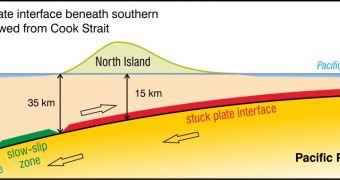The equivalent of a 7.0 magnitude earthquake has been rumbling under Wellington, New Zealand's capital city, for five months now.
Still, if it were not for a blog post put up by New Zealand's GeoNet, people living in this city probably would have remained oblivious to all the commotion taking place just below their feet.
In fact, it appears that highly specialized recording instruments have also decided to let this one slip, meaning that they failed to notice that the earthquake was and still is taking place.
“To the west of Wellington, the equivalent of a magnitude 7 earthquake is happening right now, 40 km (24.85 miles) below ground.”
“This would be Wellington’s largest earthquake in 150 years, yet nothing is felt at the surface. Even our sensitive earthquake recording instruments hardly notice a thing,” GeoNet writes in its blog post.
Specialists explain that, unlike run-off-the-mill earthquakes that act out and release whopping amounts of energy in a matter of minutes, silent earthquakes, a.k.a. slow-slip events, release their energy over longer periods.
It often happens that it takes several days for all the energy to be released and for the shake to cease, GeoNet says.
Slow-slip events have only recently been documented, and specialists say that they more often than not occur at subduction zones.
Long story short, two plates want to get past each other, get stuck and, instead of releasing all the built-up tension in one colossal effort to push through, they go through a period of smooth motion during which they gently and silently slide past one another.
The friction resulting from this motion is what caused the hardly perceptible shake.
The silent earthquake presently dragging on under New Zealand involved the Pacific and the Australian tectonic plates, and it is affecting an over 100 square kilometer area from Levin to Marlborough Sounds.
Specialists suspect that it will be months before the earthquake ends.
As GeoNet put it, “GeoNet’s continuously-running GPS instruments in Wellington and Kapiti show that the Pacific and Australian tectonic plates are slipping past each other more rapidly than usual. This has been going on since January of this year, and will most likely continue for several months.”
Although it slow-side events cannot cause any damage on their own, they can influence local seismic activity and perhaps even trigger other earthquakes.
Because of this, researchers intend to continue monitoring this silent shake under Wellington.

 14 DAY TRIAL //
14 DAY TRIAL //